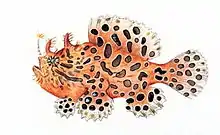Neopterygii
Neopterygii (from Greek νέος neos, new, and πτέρυξ pteryx, fin) is a subclass of ray-finned fish (Actinopterygii). Only a few changes occurred during the evolution of neopterygians from the earlier actinopterygians. They appeared sometime in the Late Permian, before the time of the dinosaurs. The neopterygians were a very successful group of fish, because they could move more rapidly than their ancestors. Their scales and skeletons began to lighten during their evolution, and their jaws became more powerful and efficient. While electroreception and the ampullae of Lorenzini are present in all other groups of fish, with the exception of hagfish (although hagfish are not actinopterygians, they are agnathans), neopterygians have lost this sense, even if it has later been re-evolved within Gymnotiformes and catfishes, which possess nonhomologous teleost ampullae.[2]
| Neopterygii | |
|---|---|
 | |
| Siganus corallinus | |
| Scientific classification | |
| Kingdom: | Animalia |
| Phylum: | Chordata |
| Class: | Actinopterygii |
| (unranked): | Actinopteri |
| Subclass: | Neopterygii Regan, 1923[1] |
| Infraclasses | |
A very important step in the evolution of the actinopterygian fishes is the origin of the neopterygians, with the acquisition of a better control of the movements of both dorsal and anal fins, resulting in an improvement in their swimming capabilities. They additionally acquired several modifications in the skull, which allowed the evolution of different feeding mechanisms and consequently the colonization of new ecological niches. All of these characters represented major improvements, resulting in Neopterygii becoming the dominant group of fishes (and, thus, taxonomically of vertebrates in general). Neopterygii also includes the teleosts, which compromise the vast majority of extant fishes.[3]
Classification
| Phylogeny of Neopterygii[4][5][6][7] | |||||||||||||||
|
- Order †Semionotiformes
- Infraclass Holostei
- Order Lepisosteiformes, the gars
- Order Amiiformes, the bowfin
- Order †Pachycormiformes
- Infraclass Teleostei
- Superorder Osteoglossomorpha
- Order Osteoglossiformes, the bony-tongued fishes
- Order Hiodontiformes, including the mooneye and goldeye
- Superorder Elopomorpha
- Order Elopiformes, including the ladyfishes and tarpon
- Order Albuliformes, the bonefishes
- Order Notacanthiformes, including the halosaurs and spiny eels
- Order Anguilliformes, the true eels
- Order Saccopharyngiformes, including the gulper eel
- Superorder Clupeomorpha
- Order Clupeiformes, including herrings and anchovies
- Superorder Ostariophysi
- Order Gonorynchiformes, including the milkfishes
- Order Cypriniformes, including barbs, carp, danios, goldfishes, loaches, minnows, rasboras
- Order Characiformes, including characins, pencilfishes, hatchetfishes, piranhas, tetras.
- Order Gymnotiformes, including electric eels and knifefishes
- Order Siluriformes, the catfishes
- Superorder Protacanthopterygii
- Order Argentiniformes, including the barreleyes and slickheads (formerly in Osmeriformes)
- Order Salmoniformes, including salmon, Arctic char, and trout
- Order Esociformes the pike
- Order Osmeriformes, including the smelts and galaxiids
- Superorder Stenopterygii (may belong in Protacanthopterygii)
- Order Ateleopodiformes, the jellynose fish
- Order Stomiiformes, including the bristlemouths and marine hatchetfishes
- Superorder Cyclosquamata (may belong in Protacanthopterygii)
- Order Aulopiformes, including the Bombay duck and lancetfishes
- Superorder Scopelomorpha
- Order Myctophiformes, including the lanternfishes
- Superorder Lampridiomorpha
- Order Lampriformes, including the oarfish, opah and ribbonfishes
- Superorder Polymyxiomorpha
- Order Polymixiiformes, the beardfishes
- Superorder Paracanthopterygii
- Order Percopsiformes, including the cavefishes and trout-perches
- Order Batrachoidiformes, the toadfishes
- Order Lophiiformes, including the anglerfishes
- Order Gadiformes, including cods
- Order Ophidiiformes, including the pearlfishes
- Superorder Acanthopterygii
- Order Mugiliformes, the mullets
- Order Atheriniformes, including silversides and rainbowfishes
- Order Beloniformes, including the flyingfishes
- Order Cetomimiformes, the whalefishes
- Order Cyprinodontiformes, including live-bearers, killifishes
- Order Stephanoberyciformes, including the ridgeheads
- Order Beryciformes, including the fangtooths and pineconefishes
- Order Zeiformes, including the dories
- Order Gobiesociformes, the clingfishes[8]
- Order Gasterosteiformes including sticklebacks
- Order Syngnathiformes, including the seahorses and pipefishes[9]
- Order Synbranchiformes, including the swamp eels
- Order Tetraodontiformes, including the sunfish, filefishes and pufferfish
- Order Pleuronectiformes, the flatfishes
- Order Scorpaeniformes, including scorpionfishes and the sculpins
- Order Perciformes 40% of all fish including anabantids, bass, cichlids, gobies, gouramis, mackerel, perches, scats, whiting, wrasses
- Superorder Osteoglossomorpha
| Wikispecies has information related to Neopterygii. |
References
- Regan, C. Tate (1923). "The Skeleton of Lepidosteus, with remarks on the origin and evolution of the lower Neopterygian Fishes". Journal of Zoology. 93 (2): 445–461. doi:10.1111/j.1096-3642.1923.tb02191.x.
- Electroreception By Theodore Holmes Bullock
- López-Arbarello, A (2012). "Phylogenetic Interrelationships of Ginglymodian Fishes (Actinopterygii: Neopterygii)". PLOS ONE. 7 (7): e39370. doi:10.1371/journal.pone.0039370. PMC 3394768. PMID 22808031.
- Betancur-R (2016). "Phylogenetic Classification of Bony Fishes Version 4".
- Nelson, Joseph, S. (2016). Fishes of the World. John Wiley & Sons, Inc. ISBN 978-1-118-34233-6.
- "Actinopterygii". Integrated Taxonomic Information System. Retrieved 3 April 2006.
- R. Froese and D. Pauly, editors (February 2006). "FishBase".
- In ITIS, Gobiesociformes is placed as the suborder Gobiesocoidei of the order Perciformes.
- In ITIS, Syngnathiformes is placed as the suborder Syngnathoidei of the order Gasterosteiformes.
